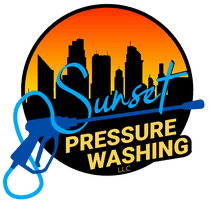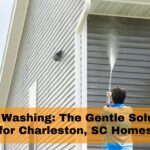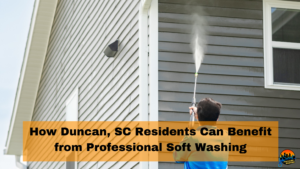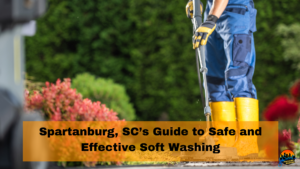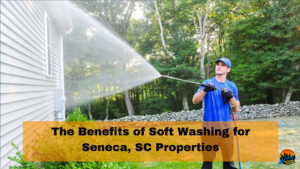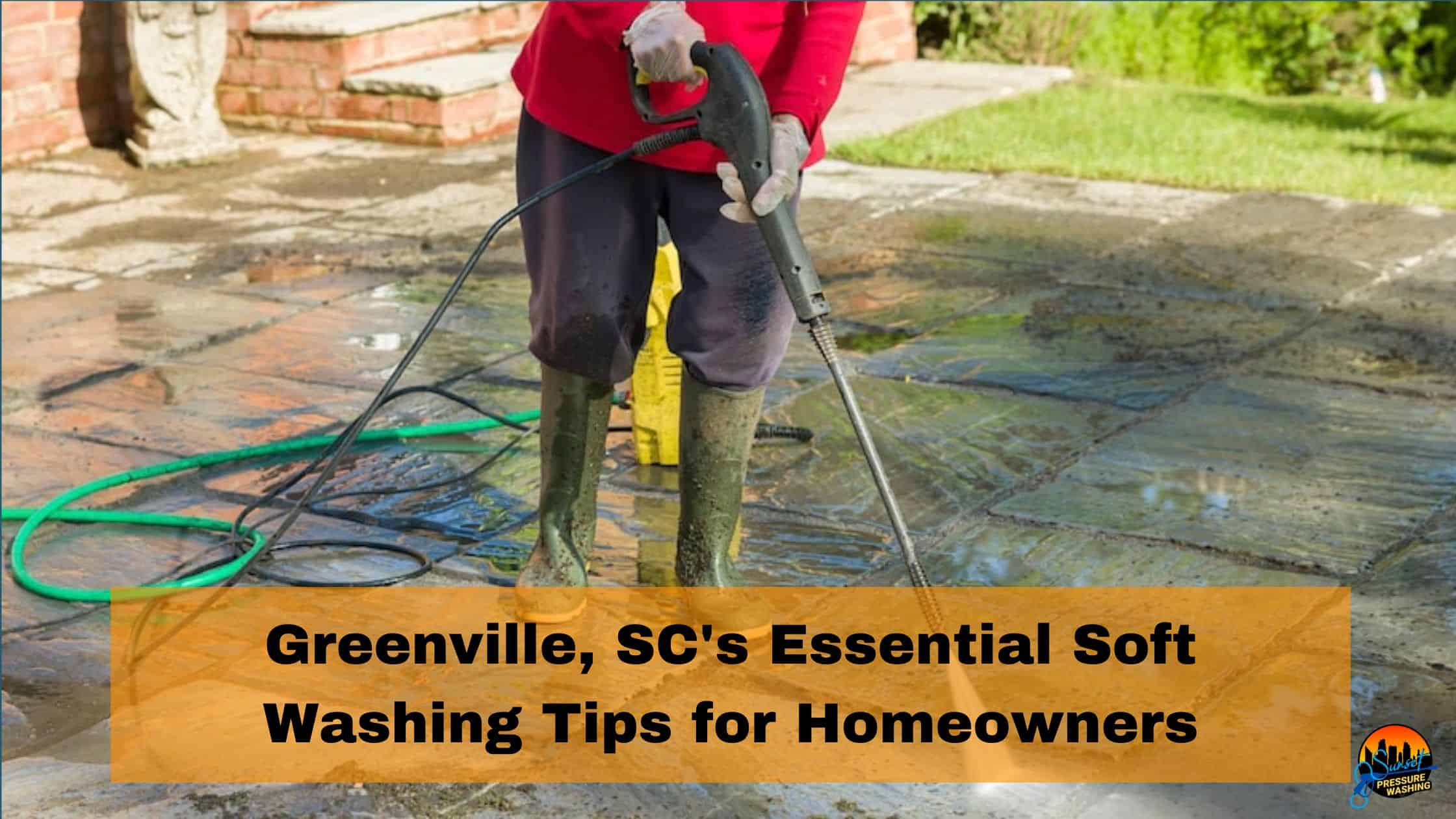
Greenville, SC's Essential Soft Washing Tips for Homeowners
Soft washing is a gentle and effective method to clean the exterior surfaces of your home. In Greenville, SC, where the climate can foster mold, mildew, and grime, soft washing is particularly beneficial. Here are some essential tips to help homeowners get the best results.
Understanding Soft Washing
Soft washing is a cleaning method that uses low-pressure water combined with specialized cleaning solutions to remove dirt, algae, mold, mildew, and other contaminants from exterior surfaces. Unlike high-pressure washing, which can be harsh and damaging to delicate surfaces, soft washing is designed to be gentle yet effective. This makes it ideal for cleaning a variety of surfaces around your home or business. For businesses in the area, commercial pressure washing services in Greenville SC provide the expertise and care needed to maintain a clean and professional appearance.
How Soft Washing Works
Soft washing systems typically use a pump to apply water at low pressure, usually around 100 PSI, which is significantly lower than the pressure used in traditional power washing. This low pressure, combined with specially formulated cleaning solutions, breaks down and removes biological growth and grime without causing damage to the surfaces being cleaned.
Benefits of Soft Washing
- Gentle on Surfaces: Soft washing is safe for delicate materials such as shingles, stucco, and painted surfaces, reducing the risk of damage that can occur with high-pressure washing.
- Effective Cleaning: The cleaning solutions used in soft washing are designed to kill mold, mildew, algae, and bacteria, not just remove them. This results in a longer-lasting clean, as the root causes of discoloration and staining are addressed.
- Eco-Friendly: Many soft washing solutions are biodegradable and environmentally friendly, making them a safer option for your home and the surrounding landscape.
- Longer-Lasting Results: Because soft washing eliminates the organisms that cause stains, surfaces stay cleaner for longer periods, reducing the need for frequent cleaning.
Ideal Surfaces for Soft Washing
Soft washing is suitable for a wide range of surfaces, including:
- Roofs: Especially shingle roofs, which can be damaged by high-pressure washing.
- Siding: Including vinyl, wood, and stucco.
- Decks and Patios: Particularly those made of softer materials like wood and composite.
- Fences: Wooden, vinyl, and other types of fences benefit from the gentle cleaning process.
- Outdoor Furniture: Soft washing can safely clean patio furniture without causing damage.
Soft Washing vs. Pressure Washing
While both methods aim to clean exterior surfaces, they do so in different ways:
- Pressure Washing: Uses high-pressure water to blast away dirt and grime, which can be effective for hard surfaces like concrete and brick but may damage softer materials.
- Soft Washing: Relies on low-pressure water and cleaning solutions to remove contaminants gently and effectively, making it suitable for a broader range of surfaces.
Choosing the Right Cleaning Solutions
Selecting the right cleaning solutions is a crucial aspect of the soft washing process. The effectiveness of soft washing largely depends on the type and quality of the cleaning agents used. Here’s a guide to help you choose the best cleaning solutions for your soft washing needs in Greenville, SC.
Biodegradable and Eco-Friendly Cleaners
When choosing a cleaning solution, prioritize products that are biodegradable and environmentally friendly. These solutions break down naturally without harming the surrounding plants, animals, and water sources. Eco-friendly cleaners are just as effective as their harsher counterparts, but they are safer for the environment and your property.
Mold and Mildew Removers
In the humid climate of Greenville, SC, mold and mildew can quickly become a problem, making professional mold and mildew removal essential. Look for cleaning solutions specifically formulated to tackle these issues. These products usually contain algaecides and fungicides that kill the mold and mildew at the root, preventing regrowth and keeping your surfaces cleaner for longer.
Surfactants and Detergents
Surfactants and detergents are key components of effective cleaning solutions. They help break down dirt, grime, and organic matter, making it easier to wash away. Ensure that the products you choose have high-quality surfactants that enhance the cleaning power of the solution without leaving behind harmful residues.
pH-Balanced Solutions
Using pH-balanced cleaning solutions is important to avoid damaging your surfaces. Acidic or alkaline cleaners can cause etching, discoloration, or other damage to delicate materials like shingles, siding, and painted surfaces. Opt for pH-neutral solutions that are gentle yet effective.
Specialty Formulas for Different Surfaces
Different surfaces may require different cleaning solutions. For example, roofs often need a different formula than siding or decks. Read the labels and choose products specifically designed for the surface you are cleaning. This ensures maximum effectiveness and prevents potential damage.
Concentration and Dilution
Many cleaning solutions come in concentrated form and need to be diluted before use. Follow the manufacturer’s instructions carefully to achieve the right dilution ratio. Using too much cleaner can be wasteful and potentially harmful, while too little may not effectively clean the surface.
Compatibility with Soft Washing Equipment
Ensure that the cleaning solutions you choose are compatible with your soft washing equipment. Some solutions may require specific types of pumps or nozzles to work effectively. Check the product specifications and consult with the equipment manufacturer if you have any doubts.
Brand Reputation and Reviews
Consider the reputation of the brand and read customer reviews before purchasing a cleaning solution. Products from well-known, reputable brands are more likely to be effective and safe. Customer reviews can provide insights into the performance and reliability of the cleaning solutions.
Availability and Local Suppliers
In Greenville, SC, many local suppliers and hardware stores carry a variety of soft washing solutions. Purchasing from local suppliers not only supports the community but also ensures that you have access to products suitable for the local climate and environmental conditions.
Professional Recommendations
If you are unsure about which cleaning solutions to choose, consider consulting with a professional soft washing service. They can provide recommendations based on their experience and expertise, ensuring that you get the best results for your specific needs.
Safety Precautions
Soft washing is an effective method for cleaning exterior surfaces, but it requires careful attention to safety. Here are essential safety precautions to follow when soft washing your home in Greenville, SC.
Wear Protective Gear
Always wear appropriate protective gear to safeguard yourself from the cleaning solutions and potential hazards. Essential protective equipment includes:
- Gloves: To protect your hands from harsh chemicals and abrasive surfaces.
- Safety Goggles: To shield your eyes from splashes of cleaning solution.
- Long-Sleeved Clothing: To protect your skin from chemical exposure.
- Non-Slip Shoes: To prevent slipping, especially when working on wet surfaces
Secure the Area
Before you start soft washing, secure the area around your home to ensure safety:
- Remove Obstacles: Clear away any objects or debris that could cause tripping or obstruct your movement.
- Cover Electrical Outlets: Use plastic sheeting or waterproof covers to protect outdoor electrical outlets from water and cleaning solutions.
- Inform Family Members: Make sure everyone in the household is aware of the cleaning process and stays clear of the work area.
Use Stable Ladders and Scaffolding
If you need to reach high areas, ensure that your ladders or scaffolding are stable and secure:
- Check for Stability: Make sure the ladder is on a flat, stable surface and not on slippery or uneven ground.
- Use a Ladder Stabilizer: Attach a stabilizer to the top of the ladder to prevent it from slipping or tipping over.
- Follow the 3-Point Rule: Maintain three points of contact with the ladder at all times (two hands and one foot, or two feet and one hand).
Handle Cleaning Solutions with Care
Cleaning solutions used in soft washing can be hazardous if not handled properly:
- Read Labels Carefully: Follow the manufacturer’s instructions and safety guidelines on the product labels.
- Mix Solutions Safely: When diluting concentrates, add the cleaning solution to water, not the other way around, to prevent splashing.
- Store Solutions Properly: Keep cleaning solutions in their original containers, tightly sealed, and out of reach of children and pets.
Avoid Working in Hazardous Conditions
Weather conditions can significantly impact safety:
- Avoid Windy Days: Wind can cause cleaning solutions to blow into unintended areas, including your face.
- Don’t Work in Rain: Wet surfaces become more slippery and hazardous.
- Watch for Heat: On hot days, take frequent breaks and stay hydrated to prevent heat exhaustion.
Protect Plants and Animals
Cleaning solutions can be harmful to plants and pets:
- Cover Plants: Use plastic sheeting or tarps to protect plants and shrubs from chemical exposure.
- Keep Pets Indoors: Ensure pets are safely indoors during the cleaning process to prevent accidental ingestion of cleaning solutions.
Be Mindful of Electrical Hazards
Water and electricity can be a dangerous combination:
- Turn Off Power: If possible, turn off the power to outdoor outlets and lights.
- Avoid Electrical Wires: Be cautious of overhead power lines and electrical wires. Never spray water directly at them.
Test a Small Area First
Before applying cleaning solutions to large areas, test a small, inconspicuous spot to ensure it doesn’t cause damage or discoloration. This step helps prevent unexpected results and damage to your property.
Know Your Limits
Soft washing can be a demanding task. If you are uncomfortable with heights, handling chemicals, or the equipment, consider hiring a professional service. Professionals have the experience and equipment to complete the job safely and effectively.
Emergency Preparedness
Be prepared for accidents or emergencies:
- First Aid Kit: Keep a first aid kit nearby for minor injuries.
- Emergency Numbers: Have emergency contact numbers readily available, including poison control in case of accidental ingestion of cleaning solutions.
Equipment Essentials
Soft washing requires specific equipment to ensure a thorough and effective cleaning process. Here are the essential tools and equipment you need to get the job done right in Greenville, SC.
Soft Washing System
A dedicated soft washing system is crucial for applying low-pressure water and cleaning solutions. This system typically includes:
- Pump: A low-pressure pump designed to deliver water and cleaning solutions at around 100 PSI, gentle enough for delicate surfaces.
- Hoses: High-quality, flexible hoses that can handle the cleaning solutions and low pressure without kinking or leaking.
- Nozzles: Various nozzles for different spray patterns, allowing you to adjust the spray for different surfaces and cleaning needs.
Cleaning Solutions
Choosing the right cleaning solutions is essential for effective soft washing:
- Biodegradable Cleaners: Eco-friendly and safe for the environment, these cleaners break down naturally without harming plants, animals, or water sources.
- Mold and Mildew Removers: Specialized solutions that kill mold and mildew at the root, preventing regrowth and ensuring a longer-lasting clean.
- Surfactants and Detergents: High-quality surfactants and detergents that help break down dirt, grime, and organic matter without leaving harmful residues.
Safety Gear
Personal safety is paramount when soft washing:
- Gloves: Chemical-resistant gloves to protect your hands from cleaning solutions.
- Safety Goggles: To shield your eyes from splashes of cleaning agents.
- Long-Sleeved Clothing: To protect your skin from chemical exposure.
- Non-Slip Shoes: Ensures you maintain a firm grip on wet and slippery surfaces.
Extension Poles
Extension poles allow you to reach high or difficult-to-access areas without using a ladder:
- Adjustable Length: Poles that can be extended to various lengths for versatility.
- Brush Attachments: Soft-bristle brushes that can be attached to the poles for scrubbing stubborn stains.
Ladders and Scaffolding
For areas that cannot be reached with extension poles:
- Sturdy Ladder: Ensure it is stable and has rubber feet to prevent slipping.
- Ladder Stabilizer: An attachment that provides additional stability, especially when working on uneven surfaces.
- Scaffolding: For extensive work on high areas, scaffolding offers a safer and more stable platform than a ladder.
Pressure Washer (Optional)
While not always necessary, a pressure washer with adjustable pressure settings can be useful for tougher surfaces like concrete or brick. Ensure it has a soft wash setting to prevent damage to delicate areas.
Garden Hose
A standard garden hose is necessary for rinsing surfaces after applying the cleaning solution:
- Hose Reel: A hose reel can help manage and store the hose neatly.
- Spray Nozzle: Attach a spray nozzle with various settings for controlled rinsing.
Tarps and Plastic Sheeting
Protect plants, shrubs, and outdoor furniture from cleaning solutions:
- Tarps: Heavy-duty tarps to cover large areas and protect them from overspray.
- Plastic Sheeting: Lightweight plastic sheeting for smaller or more delicate items.
Buckets and Containers
Buckets and containers are useful for mixing and transporting cleaning solutions:
- Measuring Tools: Include measuring cups and spoons to ensure proper dilution of cleaning agents.
- Sealable Containers: For storing leftover cleaning solutions safely.
First Aid Kit
Always have a first aid kit on hand to address minor injuries or accidents:
- Basic Supplies: Bandages, antiseptic wipes, adhesive tape, and other first aid essentials.
- Emergency Contact Numbers: Include poison control and local emergency services.
Personal Protective Equipment (PPE)
Additional PPE may be required depending on the cleaning solutions used:
- Respirator Masks: If working with strong chemicals or in poorly ventilated areas, use a respirator mask to protect your lungs.
- Ear Protection: If using loud equipment, such as a pressure washer, ear protection can prevent hearing damage.
Professional-Grade Equipment (For Hire)
For large or complex jobs, consider renting or hiring professional-grade soft washing equipment:
- Commercial Soft Washing Systems: Higher-capacity systems for extensive cleaning projects.
- Professional Services: Hiring a professional soft washing service can ensure the job is done efficiently and safely.
Pre-Wash Inspection
Before starting the soft washing process, it’s crucial to conduct a thorough pre-wash inspection. This step ensures that you identify any potential issues that could cause problems during the cleaning process and helps you prepare adequately. Here’s a detailed guide to conducting a pre-wash inspection for your home in Greenville, SC.
Inspect for Structural Damage
Carefully examine the exterior of your home for any signs of structural damage:
- Cracks and Gaps: Look for cracks in the siding, foundation, and around windows and doors. These can allow water to seep in and cause further damage.
- Loose Shingles: Check the roof for loose or missing shingles that could be dislodged during washing.
- Rotting Wood: Inspect wooden surfaces like decks, fences, and trim for signs of rot or decay, which can be exacerbated by water exposure.
Check for Mold and Mildew
Identify areas with significant mold and mildew growth:
- Roof: Inspect the roof for black streaks or patches indicating mold or mildew.
- Siding: Look for green, black, or white spots on the siding that indicate mold or mildew presence.
- Shaded Areas: Pay special attention to shaded areas, as they are more prone to mold and mildew growth.
Assess the Condition of Paint and Coatings
Examine painted surfaces and other coatings:
- Peeling Paint: Look for areas where paint is peeling or flaking, as these spots may need touch-up after washing.
- Discoloration: Check for discoloration or staining that might need special treatment or additional cleaning efforts.
Identify Sensitive Areas
Mark areas that require special attention or protection:
- Electrical Outlets and Fixtures: Note the locations of outdoor electrical outlets, light fixtures, and other electrical components that need to be covered or avoided during washing.
- Delicate Plants and Landscaping: Identify plants, flowers, and shrubs that could be damaged by cleaning solutions and need to be protected.
Check Seals and Caulking
Inspect seals and caulking around windows, doors, and other openings:
- Damaged Seals: Look for cracks or gaps in the seals that could allow water to enter your home.
- Worn Caulking: Check for caulking that is cracked, peeling, or missing and needs to be replaced.
Assess Gutters and Downspouts
Ensure that your gutters and downspouts are in good condition:
- Clogs: Check for clogs that could prevent proper drainage during washing.
- Loose Attachments: Ensure that gutters and downspouts are securely attached to the house and not damaged.
Examine Walkways and Driveways
Look at your walkways and driveways for any issues:
- Cracks and Potholes: Identify any cracks or potholes that could be worsened by water exposure.
- Stains: Note any oil or grease stains that might require additional cleaning attention.
Test a Small Area
Before starting the full soft wash, test a small, inconspicuous area:
- Cleaning Solution Test: Apply the cleaning solution to a small spot to ensure it does not cause damage or discoloration.
- Surface Durability: Check how the surface reacts to the low-pressure wash to confirm it can withstand the cleaning process.
Plan for Water Runoff
Determine where the water will flow during the washing process:
- Drainage Paths: Ensure that water runoff will not pool around the foundation or other sensitive areas.
- Neighboring Properties: Be mindful of water runoff that could affect neighboring properties and plan accordingly.
Document Findings
Record any issues you find during the inspection:
- Take Photos: Document areas of concern with photos for reference and to track the condition of your home.
- Create a Checklist: List all the issues and steps needed to address them before starting the soft wash.
Protecting Plants and Outdoor Furniture
Soft washing is a great way to clean your home’s exterior, but it’s important to take steps to protect your plants and outdoor furniture from potential damage caused by cleaning solutions and water. Here are some tips to ensure your landscaping and belongings stay safe during the soft washing process.
Cover Plants and Shrubs
Covering plants and shrubs is essential to protect them from chemical exposure:
- Plastic Sheeting: Use lightweight plastic sheeting to cover plants, shrubs, and flower beds. Secure the edges with rocks or stakes to keep the sheeting in place.
- Tarps: Heavy-duty tarps can be used for larger plants or areas. Ensure the tarps are securely fastened and cover the plants completely.
Water Plants Before and After
Watering your plants before and after soft washing helps dilute any chemicals that may come into contact with them:
- Before Washing: Thoroughly water your plants to create a barrier that can help prevent the absorption of cleaning solutions.
- After Washing: Rinse your plants with clean water immediately after the soft wash to remove any residual chemicals.
Move Potted Plants
Relocating potted plants away from the work area can prevent them from being damaged:
- Temporary Location: Move potted plants to a safe location, such as a garage, shed, or other sheltered area, until the washing is complete.
- Group Together: If you have many potted plants, group them in a protected area to make covering and moving them easier.
Protect Outdoor Furniture
Outdoor furniture is also susceptible to damage from cleaning solutions:
- Remove or Cover: If possible, remove outdoor furniture from the area being cleaned. If removal is not feasible, cover the furniture with plastic sheeting or tarps.
- Secure Covers: Ensure the covers are tightly secured to prevent them from being blown away by wind or water pressure.
Use Drop Cloths for Delicate Items
Delicate outdoor decorations and ornaments should be covered with drop cloths:
- Lightweight Protection: Use lightweight drop cloths to cover statues, fountains, and other delicate items that might be damaged by water or cleaning agents.
- Secure and Stable: Make sure the drop cloths are secured and stable to prevent them from moving during the cleaning process.
Shield Garden Beds
Garden beds can be particularly vulnerable to cleaning solutions:
- Barrier Creation: Create a barrier around garden beds using plastic sheeting or tarps to prevent chemicals from seeping into the soil.
- Elevate Edges: Elevate the edges of the sheeting or tarps slightly to ensure that water runoff does not carry chemicals into the garden beds.
Rinse Surrounding Areas
After the soft washing is complete, rinse the surrounding areas to remove any residual cleaning solution:
- Thorough Rinsing: Use a garden hose to thoroughly rinse the ground, plants, and any other areas that may have come into contact with the cleaning solution.
- Focus on Runoff Areas: Pay special attention to areas where water runoff might have carried cleaning agents, ensuring these spots are well-rinsed.
Use Eco-Friendly Cleaning Solutions
Opting for eco-friendly and biodegradable cleaning solutions can minimize potential harm to plants and outdoor furniture:
- Safe for Plants: Choose cleaning products labeled as safe for plants and environmentally friendly to reduce the risk of damage.
- Reduced Residue: Eco-friendly solutions often leave less harmful residue, making it easier to protect your landscaping and belongings.
Monitor the Weather
Choose an appropriate day for soft washing based on the weather forecast:
- Avoid Windy Days: Wind can carry cleaning solutions to unintended areas, increasing the risk of damage to plants and furniture.
- Dry Conditions: Aim for a dry, calm day to ensure the cleaning process is controlled and predictable.
Post-Cleaning Inspection
After completing the soft washing, inspect your plants and outdoor furniture:
- Check for Damage: Look for signs of chemical damage or residue on plants and furniture. Address any issues promptly.
- Reposition Items: Return potted plants and outdoor furniture to their original positions, ensuring they are clean and undamaged.
Proper Technique
Using the correct technique is essential for achieving the best results when soft washing your home. Follow these steps to ensure a thorough and effective cleaning process while protecting your property in Greenville, SC.
Prepare the Cleaning Solution
Begin by preparing the cleaning solution according to the manufacturer’s instructions:
- Measure Accurately: Use measuring tools to ensure you mix the correct ratio of cleaning solution to water.
- Follow Instructions: Carefully follow the product’s guidelines for dilution and mixing to ensure maximum effectiveness and safety.
Test a Small Area
Before applying the solution to a large area, test it on a small, inconspicuous spot:
- Check for Reactions: Ensure that the surface does not react negatively to the cleaning solution, such as discoloration or damage.
- Adjust If Needed: Make any necessary adjustments to the dilution or application method based on the test results.
Apply the Cleaning Solution
Using your soft washing system, apply the cleaning solution to the surface:
- Start from the Bottom: Begin at the bottom of the surface and work your way up. This helps prevent streaking and ensures even coverage.
- Overlap Passes: Overlap each pass slightly to avoid missed spots and ensure complete coverage.
Allow Dwell Time
Give the cleaning solution time to work:
- Follow Instructions: Allow the solution to sit for the recommended amount of time, usually between 10-15 minutes, but not so long that it dries on the surface.
- Monitor the Area: Keep an eye on the treated area to ensure the solution remains wet and active. Reapply if necessary to maintain effectiveness.
Use Proper Pressure Settings
Ensure your equipment is set to the correct pressure:
- Low Pressure: Keep the pressure around 100 PSI to avoid damaging delicate surfaces. High pressure can strip paint, damage siding, and harm roofing materials.
- Appropriate Nozzle: Use a wide-angle nozzle to disperse the water and cleaning solution gently.
Rinse Thoroughly
After the cleaning solution has had time to work, rinse the surface thoroughly:
- Start from the Top: Begin rinsing from the top and work your way down. This helps wash away the dirt and cleaning solution more effectively.
- Consistent Movement: Use a steady, sweeping motion to ensure even rinsing and avoid streaks.
Be Mindful of Water Runoff
Manage the water runoff to prevent damage and ensure environmental safety:
- Direct Runoff Away: Ensure that water runoff is directed away from sensitive areas like garden beds, electrical outlets, and neighboring properties.
- Contain and Control: Use barriers or trenches if necessary to control and contain the runoff.
Handle Tough Stains Separately
For areas with tough stains or heavy buildup, additional steps may be needed:
- Scrub Stubborn Areas: Use a soft-bristle brush attached to an extension pole to gently scrub stubborn stains before rinsing.
- Reapply Solution: For particularly tough spots, you may need to reapply the cleaning solution and allow additional dwell time.
Maintain Consistent Technique
Consistency is key to achieving a uniform clean:
- Even Application: Apply the cleaning solution evenly and maintain a consistent distance from the surface while rinsing.
- Monitor Progress: Regularly check your progress to ensure even cleaning and address any missed areas promptly.
Post-Cleaning Inspection
After completing the soft washing process, conduct a thorough inspection:
- Check for Missed Spots: Identify any areas that may need additional attention or touch-ups.
- Assess Surface Condition: Ensure that the surface is clean and free of streaks or damage.
Clean Up
Proper cleanup is important to maintain your equipment and property:
- Rinse Equipment: Rinse out your soft washing equipment, including hoses and nozzles, to prevent buildup and prolong their lifespan.
- Dispose of Waste: Dispose of any leftover cleaning solution according to local regulations, and clean up any protective coverings or barriers used during the process.
Roof Soft Washing
Roof soft washing is a specialized technique designed to clean and maintain your roof without causing damage. Given the unique climate and environmental conditions in Greenville, SC, roof soft washing can help prevent algae, mold, and mildew growth while extending the lifespan of your roof. Here are the essential steps and tips for effective roof soft washing.
Understand Roof Soft Washing
Roof soft washing uses low-pressure water combined with specialized cleaning solutions to remove contaminants from roofing materials without causing damage. This method is particularly suitable for delicate roofing materials like shingles, tiles, and metal roofs.
Choose the Right Cleaning Solution
Selecting the appropriate cleaning solution is crucial for roof soft washing:
- Algaecides and Fungicides: Use solutions specifically designed to kill algae, mold, and mildew, which are common on roofs in humid climates.
- Biodegradable Cleaners: Opt for eco-friendly and biodegradable cleaning solutions to minimize environmental impact and protect your landscaping.
Safety First
Roof soft washing involves working at heights, so safety is paramount:
- Protective Gear: Wear non-slip shoes, gloves, and safety goggles to protect yourself from cleaning chemicals and potential falls.
- Stable Ladder: Use a sturdy ladder with a stabilizer to ensure it remains secure while you work. Consider using scaffolding for added safety.
Inspect the Roof
Before starting, thoroughly inspect your roof for any damage:
- Loose Shingles: Identify and secure any loose or missing shingles to prevent further damage during the washing process.
- Cracks and Leaks: Look for cracks, leaks, or other signs of damage that need to be repaired before washing.
Protect Surrounding Areas
Ensure that the areas around your home are protected:
- Cover Plants and Shrubs: Use plastic sheeting or tarps to cover plants and shrubs near the roofline to protect them from cleaning solutions.
- Move Outdoor Furniture: Relocate outdoor furniture away from the work area to prevent damage.
Apply the Cleaning Solution
Use a low-pressure sprayer to apply the cleaning solution:
- Bottom to Top: Start applying the solution from the bottom of the roof and work your way up. This technique prevents streaking and ensures even coverage.
- Allow Dwell Time: Let the cleaning solution sit on the roof for the recommended dwell time, usually 10-15 minutes, to break down algae, mold, and mildew.
Gentle Scrubbing for Stubborn Stains
For stubborn stains or heavy buildup:
- Soft-Bristle Brush: Use a soft-bristle brush attached to a long handle to gently scrub the affected areas. Avoid walking on the roof to prevent damage.
- Avoid Abrasive Tools: Do not use harsh or abrasive tools that could damage the roofing material.
Rinse Thoroughly
After the cleaning solution has had time to work, rinse the roof thoroughly:
- Top to Bottom: Start rinsing from the top of the roof and work your way down to ensure that all the cleaning solution and contaminants are washed away.
- Low Pressure: Use low pressure to rinse the roof, maintaining the integrity of the roofing materials.
Monitor Water Runoff
Manage water runoff to protect your property:
- Direct Away from Foundation: Ensure that water runoff is directed away from your home’s foundation and other sensitive areas.
- Contain and Dispose: Contain and properly dispose of any runoff that contains cleaning solutions to prevent environmental contamination.
Post-Cleaning Inspection
Once the roof is clean, conduct a thorough inspection:
- Check for Damage: Look for any signs of damage or areas that may need additional cleaning.
- Ensure Cleanliness: Confirm that all algae, mold, and mildew have been effectively removed.
Regular Maintenance
Schedule regular maintenance to keep your roof in optimal condition:
- Annual Cleaning: Plan to soft wash your roof annually or as needed based on the local climate and environmental conditions.
- Preventive Measures: Consider installing zinc or copper strips along the roofline to prevent algae growth.
Professional Assistance
Consider hiring professional roof soft washing services for best results:
- Experienced Professionals: Professionals have the expertise and equipment to safely and effectively clean your roof.
- Peace of Mind: Hiring professionals can save you time and ensure the job is done correctly without risking personal injury or damage to your roof.
The Ultimate Guide to Soft Washing Your Home in Greenville, SC: Essential Tips for Homeowners
Maintaining the cleanliness and appearance of your home in Greenville, SC, is essential for its longevity and curb appeal. By incorporating residential pressure washing in Greenville SC, alongside these essential soft washing tips, you can effectively remove dirt, mold, mildew, and other contaminants without damaging your property. Whether you’re tackling the project yourself or hiring professionals, taking the time to understand proper techniques, safety precautions, and the right equipment will ensure the best results.
For homeowners seeking expert assistance, consider hiring a professional service like Sunset Pressure Washing. Our experienced team offers comprehensive soft washing services tailored to meet the unique needs of your home. Our experienced team offers comprehensive soft washing in Greenville SC, as well as in Charleston SC, Simpsonville SC, and other parts of South and North Carolina. Visit Sunset Pressure Washing to learn more and schedule your appointment today. Trust the professionals to keep your home looking its best all year round.
